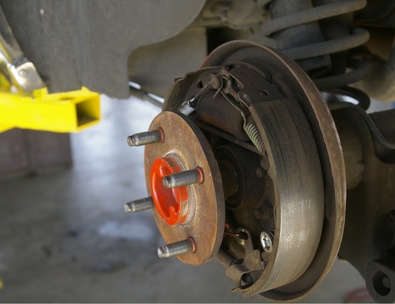
A vehicle that experiences excessive vibrations while moving, erratic steering while braking or extreme looseness in the steering system may indicate problems with the wheel bearings. Different vehicle models will require varying specialty tools for removing the wheel bearing system, yet much of the process will be similar, if not, the same.
Loosen, but do not remove, the tires' lug nuts with a tire iron. Raise the vehicle using a floor jack placed below the center of the engine. Insert jack stands on the modified frame parts below the front doors, which are reinforced for the jack stands to support the vehicle's weight. Place chop blocks behind the rear wheels and put the vehicle in park using the emergency brake for added security. Finish unscrewing the lug nuts and remove the tires.
Use a socket or torque wrench to unscrew the mounting bolts from the brake caliper. Hang the brake caliper from the coil spring by using a bent wire clothes-hanger. This ensures the brake line does not slip off and spill brake fluid. Pull out the cotter pin and remove the rotor from the vehicle.
Unscrew the mounting bolts for the steering knuckle if necessary to access the wheel hub.
Remove the hub nut by using a torque wrench and tire iron. Wedge the tire iron between two of the tire mounting studs, with one end of the tire iron resting on the ground. This prevents the wheel from turning while removing the hub nut. Unscrew the hub mounting bolts using a socket wrench. Pull out the pinion gear from the hub shaft. Pull off the wheel hub from the wheel drum.
Use a wrench to unscrew the hub outer assembly. Some models may require the use of a bearing puller. You may need to hit the end of the wrench lightly with a hammer to loosen it from the hub. Use the hub-bearing puller, which is then placed on top of the bearing assembly, and a socket wrench to remove the bearing assembly.
Use an angle grinder to cut the race or shaft seal assembly in half to remove it from the hub assembly. Cut a line through the race, and use a hammer and chisel to separate the race ring halves.
Clean the hub and bearing assembly with a rag and degreaser.
Use a wheel bearing grease tool to help pack the bearing assembly with grease. Install the new shaft seal and bearing on top of the bearing hub. Use a socket and hammer to seat the new bearing on top of the hub assembly. Screw the hub nut and pinion on top of the hub assembly. Listen for a metallic clicking noise from the bearings, which indicates they have reached the correct depth for the bearing assembly.
Reinstall all components in the reverse order, starting with the hub mounting bolts, hub bearing assembly, rotor, caliper and wheel. Also be sure you use a new cotter pin for your rotor/ hub assembly. Test the car by taking it for a spin around the block, listening for clicking sounds or loose, erratic steering.